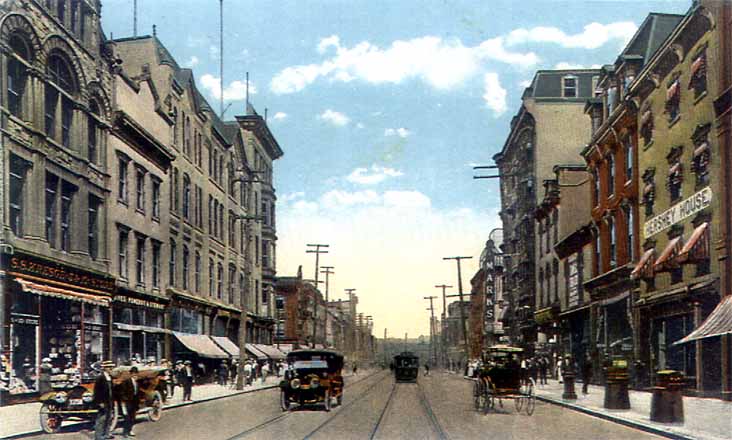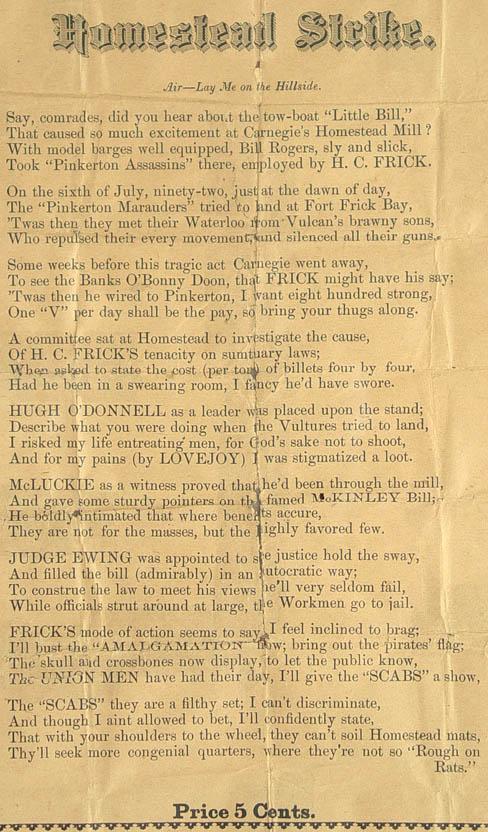|
Morewood Massacre
The Morewood massacre was an armed labor-union conflict in Morewood, Pennsylvania, in Westmoreland County, west of the present-day borough Mount Pleasant in 1891. Casualties and causes Nine coke workers were shot and killed during a strike for higher wages and an eight-hour work day. The United Mine Workers union, formed only the previous year, organized the strike against the local coke works owned by industrialist Henry Clay Frick. After a work stoppage beginning on February 10, weeks of increasing unrest, and evictions of mining families from company-controlled property, a crowd of about a thousand strikers accompanied by a brass band marched on the company store. Deputized members of the 10th regiment of the National Guard under the command of Captain Loar fired several volleys into the crowd, killing six strikers outright and fatally wounding three more. Thousands attended their funeral. A Pennsylvania state historical marker describing the Morewood event was erected ... [...More Info...] [...Related Items...] OR: [Wikipedia] [Google] [Baidu] |
Westmoreland County, Pennsylvania
Westmoreland County is a county in the Commonwealth of Pennsylvania, United States. As of the 2020 census, the population was 364,663. The county seat is Greensburg. Formed from, successively, Lancaster, Northumberland, and later Bedford counties, Westmoreland County was founded on February 26, 1773, and was the first county in the colony of Pennsylvania whose entire territorial boundary was located west of the Allegheny Mountains. Westmoreland County originally included the present-day counties of Fayette, Washington, Greene, and parts of Beaver, Allegheny, Indiana, and Armstrong counties. It is named after Westmorland, a historic county of England. Westmoreland County is included in the Pittsburgh Metropolitan Statistical Area. History Formed from Lancaster, Northumberland, and later Bedford counties, Westmoreland County was founded on February 26, 1773, and was the first county in the Pennsylvania colony whose entire territorial boundary was located west of the Alle ... [...More Info...] [...Related Items...] OR: [Wikipedia] [Google] [Baidu] |
Harrisburg, Pennsylvania
Harrisburg is the capital city of the Commonwealth of Pennsylvania, United States, and the county seat of Dauphin County. With a population of 50,135 as of the 2021 census, Harrisburg is the 9th largest city and 15th largest municipality in Pennsylvania. Harrisburg is situated on the east bank of the Susquehanna River. It is the larger principal city of the Harrisburg–Carlisle metropolitan statistical area, also known as the Susquehanna Valley, which had a population of 591,712 as of 2020, making it the fourth most populous metropolitan area in Pennsylvania after the Philadelphia, Pittsburgh, and Lehigh Valley metropolitan areas. Harrisburg played a role in American history during the Westward Migration, the American Civil War, and the Industrial Revolution. During part of the 19th century, the building of the Pennsylvania Canal and later the Pennsylvania Railroad allowed Harrisburg to develop into one of the most industrialized cities in the Northeastern United States. ... [...More Info...] [...Related Items...] OR: [Wikipedia] [Google] [Baidu] |
1891 In Pennsylvania
Events January–March * January 1 ** Paying of old age pensions begins in Germany. ** A strike of 500 Hungarian steel workers occurs; 3,000 men are out of work as a consequence. **Germany takes formal possession of its new African territories. * January 2 – A. L. Drummond of New York is appointed Chief of the Treasury Secret Service. * January 4 – The Earl of Zetland issues a declaration regarding the famine in the western counties of Ireland. * January 5 **The Australian shearers' strike, that leads indirectly to the foundation of the Australian Labor Party, begins. **A fight between the United States and Indians breaks out near Pine Ridge agency. **Henry B. Brown, of Michigan, is sworn in as an Associate Justice of the Supreme Court. **A fight between railway strikers and police breaks out at Motherwell, Scotland. * January 6 – Encounters continue, between strikers and the authorities at Glasgow. * January 7 ** General Miles' forces s ... [...More Info...] [...Related Items...] OR: [Wikipedia] [Google] [Baidu] |
1891 Labor Disputes And Strikes
Events January–March * January 1 ** Paying of old age pensions begins in Germany. ** A strike of 500 Hungarian steel workers occurs; 3,000 men are out of work as a consequence. **Germany takes formal possession of its new African territories. * January 2 – A. L. Drummond of New York is appointed Chief of the Treasury Secret Service. * January 4 – The Earl of Zetland issues a declaration regarding the famine in the western counties of Ireland. * January 5 **The Australian shearers' strike, that leads indirectly to the foundation of the Australian Labor Party, begins. **A fight between the United States and Indians breaks out near Pine Ridge agency. **Henry B. Brown, of Michigan, is sworn in as an Associate Justice of the Supreme Court. **A fight between railway strikers and police breaks out at Motherwell, Scotland. * January 6 – Encounters continue, between strikers and the authorities at Glasgow. * January 7 ** General Miles' forces s ... [...More Info...] [...Related Items...] OR: [Wikipedia] [Google] [Baidu] |
Murder Of Workers In Labor Disputes In The United States
The following list of worker deaths in United States labor disputes captures known incidents of fatal labor-related violence in U.S. labor history, which began in the colonial era with the earliest worker demands around 1636 for better working conditions. It does not include killings of enslaved persons. According to a study in 1969, the United States has had the bloodiest and most violent labor history of any industrial nation in the world, and there have been few industries which have been immune.Philip Taft and Philip Ross, "American Labor Violence: Its Causes, Character, and Outcome," The History of Violence in America: A Report to the National Commission on the Causes and Prevention of Violence, ed. Hugh Davis Graham and Ted Robert Gurr, 1969. This list is not comprehensive. A number of factors (multi-sided conflicts, physically remote locations, company-controlled locations, exaggerated or biased original reporting, etc.) make some of the death and injury counts uncertain. I ... [...More Info...] [...Related Items...] OR: [Wikipedia] [Google] [Baidu] |
Mammoth Mine Disaster
The Mammoth Mine disaster or Frick Mine explosion occurred on January 27, 1891 just after 9:00 AM in the Mammoth No. 1 mine in Mount Pleasant Township, Westmoreland County, Pennsylvania. Newspapers reported that firedamp was ignited by a miner's oil lamp, resulting in the deaths of 109 men and boys. Most of the miners were not killed by the force of the explosion, but rather were suffocated by the effects of afterdamp. The Mammoth mines The Mammoth mining complex consisted of the Mammoth No. 1 Mine (a shaft mine) and the Mammoth No. 2 Mine (a slope mine). From approximately 1879 to 1889 the Mammoth No. 1 mine was owned by Colonel J.W. Moore Coke Company in Greensburg, PA Greensburg is a city in and the county seat of Westmoreland County, Pennsylvania, United States, and a part of the Pittsburgh Metro Area. The city lies within the Laurel Highlands and the ecoregion of the Western Allegheny Plateau. The city is .... In 1889, the mine was purchased by The H. C. Frick Coke ... [...More Info...] [...Related Items...] OR: [Wikipedia] [Google] [Baidu] |
Johnstown Flood
The Johnstown Flood (locally, the Great Flood of 1889) occurred on Friday, May 31, 1889, after the catastrophic failure of the South Fork Dam, located on the south fork of the Little Conemaugh River, upstream of the town of Johnstown, Pennsylvania, United States. The dam ruptured after several days of extremely heavy rainfall, releasing 14.55 million cubic meters of water. With a volumetric flow rate that temporarily equaled the average flow rate of the Mississippi River,Sid Perkins, "Johnstown Flood matched volume of Mississippi River" ''Science News'', Vol.176 #11, 21 November 2009, accessed 14 October 2012 the flood killed 2,209 people and accounted for $17 million of damage (about $534 ... [...More Info...] [...Related Items...] OR: [Wikipedia] [Google] [Baidu] |
Homestead Strike
The Homestead strike, also known as the Homestead steel strike, Homestead massacre, or Battle of Homestead, was an industrial lockout and strike that began on July 1, 1892, culminating in a battle in which strikers defeated private security agents on July 6, 1892. The governor responded by sending in the National Guard to protect strikebreakers. The dispute occurred at the Homestead Steel Works in the Pittsburgh-area town of Homestead, Pennsylvania, between the Amalgamated Association of Iron and Steel Workers (the AA) and the Carnegie Steel Company. The final result was a major defeat for the union strikers and a setback of decades for their efforts to unionize steelworkers. The battle was a pivotal event in U.S. labor history. Background Carnegie Steel made major technological innovations in the 1880s, especially the installation of the open-hearth system at Homestead in 1886. It now became possible to make steel suitable for structural beams and for armor plate for the Uni ... [...More Info...] [...Related Items...] OR: [Wikipedia] [Google] [Baidu] |
List Of Pennsylvania State Historical Markers In Westmoreland County
__NOTOC__ This is a list of the Pennsylvania state historical markers in Westmoreland County. This is intended to be a complete list of the official state historical markers placed in Westmoreland County, Pennsylvania by the Pennsylvania Historical and Museum Commission (PHMC). The locations of the historical markers, as well as the latitude and longitude coordinates as provided by the PHMC's database, are included below when available. There are 45 historical markers located in Westmoreland County. Historical markers See also *List of Pennsylvania state historical markers *National Register of Historic Places listings in Westmoreland County, Pennsylvania References External linksPennsylvania Historical Marker Program {{Pennsylvania Historical and Museum Commission Histo ... [...More Info...] [...Related Items...] OR: [Wikipedia] [Google] [Baidu] |
Pennsylvania Historical And Museum Commission
The Pennsylvania Historical and Museum Commission (PHMC) is the governmental agency of the Commonwealth of Pennsylvania responsible for the collection, conservation and interpretation of Pennsylvania's historic heritage. The commission cares for historical manuscripts, public records, and objects of historic interest; museums; archeology; publications; historic sites and properties; historic preservation; geographic names; and the promotion of public interest in Pennsylvania history. PHMC was established June 6, 1945, by state Act No. 446, merging the Pennsylvania Historical Commission (PHC), Pennsylvania State Museum and Pennsylvania State Archives. The commission is an independent administrative board, consisting of nine citizens of the Commonwealth appointed by the Governor; the Secretary of Education ex officio; two members of the Senate appointed by the President Pro Tempore and Minority Leader; and two members of the House of Representatives appointed by the Speaker and M ... [...More Info...] [...Related Items...] OR: [Wikipedia] [Google] [Baidu] |
Workers Attack Frick Coal Mine 1891
The workforce or labour force is a concept referring to the pool of human beings either in employment or in unemployment. It is generally used to describe those working for a single company or industry, but can also apply to a geographic region like a city, state, or country. Within a company, its value can be labelled as its "Workforce in Place". The workforce of a country includes both the employed and the unemployed (labour force). Formal and informal Formal labour is any sort of employment that is structured and paid in a formal way.Seager, Joni. 2008. The Penguin Atlas of Women in the World. 4th ed. New York: Penguin Books. Part 5 Unlike the informal sector of the economy, formal labour within a country contributes to that country's gross national product. Informal labour is labour that falls short of being a formal arrangement in law or in practice. It can be paid or unpaid and it is always unstructured and unregulated.Seager, Joni. 2008. The Penguin Atlas of Women in ... [...More Info...] [...Related Items...] OR: [Wikipedia] [Google] [Baidu] |




